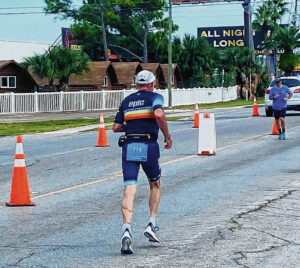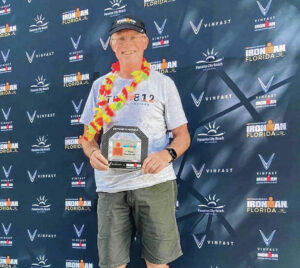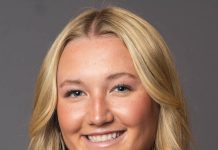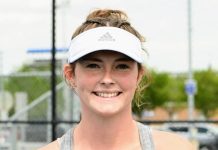
Jim Lewis crosses the finish line to win the men’s 65-69-year-old division in the Ironman Florida triathlon on Nov. 5 in Panama City Beach, Florida.
Submitted photo
Jim Lewis was 53 years old when he met Ben Weaver and told him he wanted to do a full Ironman Triathlon.
In the 12 years since then, Lewis has undergone back surgery, broken ribs and collarbone and open heart surgery, but his goal of doing an Ironman never wavered.
Last month, Lewis not only completed his first Ironman following the surgery, he won the men’s 65-69-year-old division at the Ironman Florida to qualify for the Ironman World Championships.
“I think ‘Gritty’ is probably the one word in how I would describe Jim Lewis because to me, grit is this tenacity and this never-ending drive to accomplish whatever goal you set, and every little road block that we have been confronted with from 2010 when we met to almost doubting the conversation we had that this guy was going to do an Ironman, all the way up until his heart surgery, he has never wavered one moment,” Weaver said. “I’m being honest when I’m saying there isn’t one conversation, text exchange, e-mail, that there was a conversation where I had to convince him to stay in the fight to reach whatever goal he had. It’s always been the most impressive thing to me, as well as his teammates, his friends, his family, his colleagues have always looked up to Jim in terms of never giving up on whatever your goals are.”
Lewis qualified for the 2023 Ironman World Championships, but on Wednesday, FINA, the sport’s governing body, decided to separate the men’s and women’s locations beginning next year. The women’s event will remain in Kona, Hawaii, while the men could be moving to Nice, France.
Qualifiers for the 2023 event were given the option to defer their entry to 2024, when the men’s event will be back in Hawaii, and Lewis has decided to take that route.
“It just seemed like the nostalgia for me, going to Hawaii, is more appealing than going to France,” Lewis said.
Giving triathlons a try
Lewis was living in Farmland, about 15 miles east of Muncie, when he signed up for the 1987 Muncie Endurathon. The half-Ironman event features a 1.2-mile swim, 56-mile bike and 13.1-mile run.
That same year, Lewis and his wife Cindy and their three kids moved to Columbus, but he didn’t do any triathlons while the kids were growing up.
In 2010, after their kids were grown, Jim signed up for the Indianapolis mini-marathon. He was going through the “Pace for the Race” training program with Shayla Holtkamp when he met Weaver, who was giving a lecture on strength training and stretching.
“At that time, I knew I wanted to do a full Irnoman sometime before I got to the point where I couldn’t do any at all,” Lewis said. “So I introduced myself to Ben and asked him to be my coach because I knew I needed coaching to go that far.”
Weaver, who owns EPIC Coaching and Training, was a little bit skeptical.
“I specifically remembered Jim because he was this quiet, mild-mannered gentleman that came up to me afterward,” Weaver said. “We struck up an interesting conversation, and he said his goal was to do a full Ironman one day. My first thought is, I’ve had those conversations with a number of people probably four or five times a year, and I just thought this was going to be another one of those conversations where I won’t see Jim again. But lo and behold, here we are, 12 years later, still working together.”
Overcoming adversity
The first setback in Lewis’ quest to do an Ironman came in January 2017, when he found out he had a herniated disc in his back. He underwent surgery in March of that year, but the injury had left him with permanent nerve damage in his foot.
Nevertheless, Lewis did the Louisville Ironman in October 2017, completing the 2.4-mile swim, 112-mile bike and 26.2-mile marathon run.
“I didn’t know if I was even going to start,” Lewis said. “We talked about it and I thought, ‘Well, heck, if I start and get so far, I’ll quit. I probably walked 21 of those 26 miles in that one because I just couldn’t run on my foot.”
Lewis made it through 2018 and the first half of 2019 without any major health problems, but then wrecked his bicycle in September 2019 and broke four ribs and his collarbone. That took him out of an event in Augusta, Georgia, but he came back to do the Daytona Clash half-Ironman in December of that year.
When Lewis went back to Daytona in December 2020, he sensed that something was a little off. In May 2021, he went in to his doctor, who performed an ECG, then sent him immediately to Franciscan Hospital in Indianapolis for a full EKG.
After seeing the results, Lewis underwent a heart catheterization. Doctors determined that stints were not applicable, so they performed coronary quadruple bypass surgery in June 2021.
“After that, it was just exercising and trying to get back into what I was doing before,” Lewis said. “I kind of looked at it as though it was just another hurdle that I was going through, that I had to just get through and get back to a normal life,” Lewis said. “The foot issue after my back surgery was more disconcerting a little bit because I was having more issues running. But I would walk-run-walk-run, and eventually, I was able to just fully run. So I never really took the attitude that I couldn’t do anything that I couldn’t do before. I just would deal with whatever situation was given me and kept going.”
Lewis ran the 5K at the Mill Race Marathon in September 2021 and finished second in his age group. He did the sprint triathlon in Daytona last December, then trained through the winter.
In May, Lewis finished 11th in his age group in a half-Ironman in Chattanooga, Tennessee. He placed third in his age group in a half-Ironman in Michigan in July and won his age group at a Tri-Indy race in July and again at the Columbus Challenge Triathlon in August. In his final tuneup for the Florida Ironman, he took second in his age group in Muncie 70.3, a half-Ironman in October.
Lewis said he never had the classic symptoms of a heart attack like radiating pain in his left arm and jaw, only that he experienced a little discomfort in his chest. He previously could sustain a heart rate in low-to-mid 150s, and now sustains a heart rate in 130s easily and 140s for short periods. He wears chest heart rate monitor for just about every activity.
“When I was in the hospital, the nurses and the doctors couldn’t believe how well I was recovering,” Lewis said. “But some of that was that I was in good shape going in. Any form of exercise is good for you, and if it’s walking around the block, some form of exercise is good for you. You don’t have to do the rigors of an Ironman training program to stay in shape. Part of it is just listening to your body and what it tells you.”
Shocking victory
Lewis wasn’t thinking about winning his age group and qualifying for the World Championships when he started the Ironman Florida event on Nov. 5 in Panama City Beach.
If he wasn’t thinking about it at the beginning, he certainly wasn’t when he was 13 minutes behind the age group leader after the swim and bike portions. But over the first 15 miles of the run, Lewis was chipping away at the lead.
“He was getting so close to the front of the race that his lovely wife Cindy called me and said, ‘Ben, what do I do? What do I tell him? What do we talk about?’ This was new territory for the Lewises,” Weaver said. “The instruction was that we have to tell him he’s in the lead because that can usually reset your mind if you’re in a bad place, or you’re suffering in that race. Knowing that you’re in the lead can sometimes reset your energy level, reset your sights to be able to stay in the moment and charge up to the finish line, but also stay relaxed and make sure that he’s breathing, he’s eating, drinking, relaxing and just staying ready for the rest of the day.”
 Jim Lewis makes his way through the Ironman Florida triathlon on Nov. 5 in Panama City Beach, Florida.
Jim Lewis makes his way through the Ironman Florida triathlon on Nov. 5 in Panama City Beach, Florida.
Submitted photo
Shortly thereafter, Lewis took the lead and kept it for the remainder of the race.
“It freaked me out when my wife first told me I was in second place because I had no clue where I was at,” Lewis said. “(The goal) was just to go do the race. (Winning) wasn’t even on the radar. Even for me to be on the podium at a full Ironman distance race would have been just ecstatic to me, because even that wasn’t even on the radar going into that race. The race was deferred because I had heart surgery, and I was just wanting to go better my time from 11 years ago.”
Lewis’ time of 12 hours, 48 minutes was a personal best for a full Ironman, 16 months after undergoing heart surgery.
 Jim Lewis accepts his award for winning the men’s 65-69-year-old division in the Ironman Florida triathlon on Nov. 5 in Panama City Beach, Florida.
Jim Lewis accepts his award for winning the men’s 65-69-year-old division in the Ironman Florida triathlon on Nov. 5 in Panama City Beach, Florida.
Submitted photo
“I think that the results that we’re seeing are a testament to his patience in the long term,” Weaver said. “Endurance sports take a long-term investment over time, so you may never see the results in Year 1, 2, 3, 4 that you’re hoping for. But at some point, when you stick to it, and you don’t let hurdles get in your way, and you just keep showing up every day and just give what you have on that particular day, at some point, all that work pays off, and you end up with result just like Jim has.”
Supporting roles
A self-employed structural engineering consultant, Lewis trains with the Tri-812 triathlon club and works with Weaver at the MVP gym on strength training through EPIC coaching and training.
“A lot of our training and coaching really is led by the limits which his cardiologist sets for us,” Weaver said. “It’s my responsibility to set the program based on those parameters, making sure that we’re getting an adequate amount of rest and recovery, more than we ever have, and making sure that all of those intensities, regardless of how good he’s doing a particular day, that he stays within those guidelines.”
 Jim Lewis and his wife Cindy show some of the EPIC uniforms he has worn since beginning to work with EPIC coach Ben Weaver in 2010.
Jim Lewis and his wife Cindy show some of the EPIC uniforms he has worn since beginning to work with EPIC coach Ben Weaver in 2010.
Submitted photo
Lewis also credited Cindy, who sometimes rides a bike with him on his long runs.
“I can’t say enough about the support that my wife has provided,” Jim said. “She was supporting me even back when we were doing the mini-marathons. Since the 80s, there’s probably only been less than a handful of races that my wife hasn’t been at. This is kind of new to her as far as the level that I’m at, but she’s the biggest supporter, and a close second is Ben and his group and all the friends and everybody else here in Columbus.”
Weaver said if people didn’t know Jim’s story, if somebody hasn’t shared his story, they would never know it happened because he doesn’t ever talk about it.
“It’s never an excuse,” Weaver said. “It doesn’t get in the way of his training. We’ve always been able to adjust and modify his training, whether it’s in the gym or out in the field whether swimming, biking or running to accommodate where he is with his recovery or his energy levels with his physician restrictions as he was coming back from surgery.
“If you listen to his trajectory these last 18 months, these stairstep climbs as he’s moving his way toward the front of his age group, where he used to sit in that top 10, and then step by step, he’s been able to get up to the front end of the race, the last few months, as we tracked his progress and watched him on race day, he’s always been in that fight,” he added. “He’s always been in that first, second and third all day long, and I think Florida is just a dream-come-true for him. It’s a dream-come-true for me, at least. It’s literally a gift that is almost a ‘thank you’ for everything that he’s done for himself to get himself that result to be able to go to Hawaii and race for the World Championship.”




